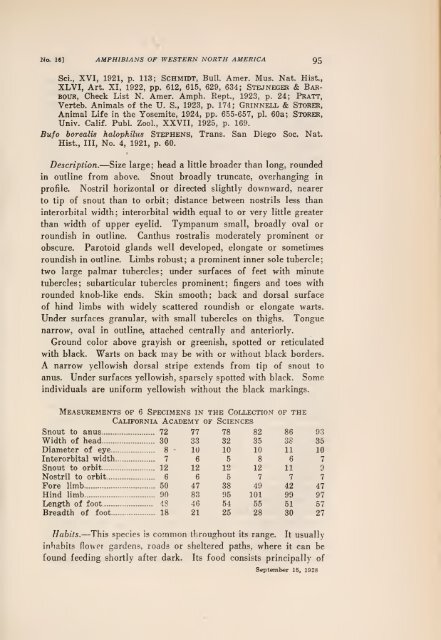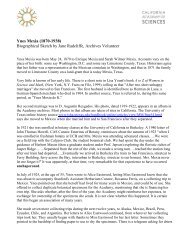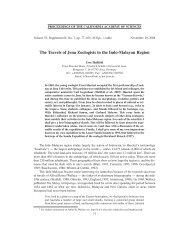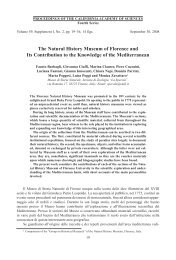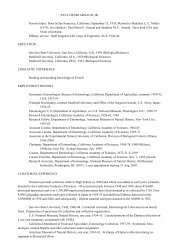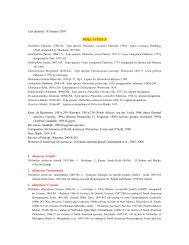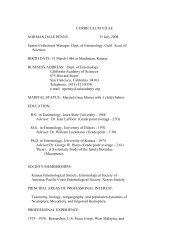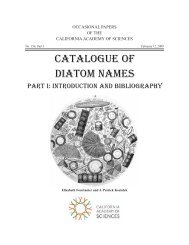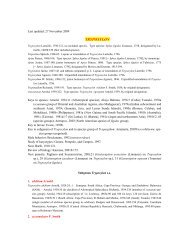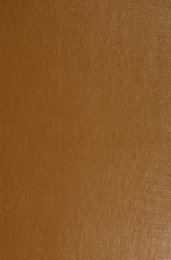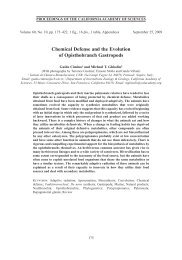PDF (9.91 MB) - Academy Research - California Academy of Sciences
PDF (9.91 MB) - Academy Research - California Academy of Sciences
PDF (9.91 MB) - Academy Research - California Academy of Sciences
You also want an ePaper? Increase the reach of your titles
YUMPU automatically turns print PDFs into web optimized ePapers that Google loves.
No. 16] AMPHIBIANS OF WESTERN NORTH AMERICA 95<br />
Sci., XVI, 1921, p. 113; Schmidt, Bull. Amer. Mus. Nat. Hist.,<br />
XLVI, Art. XI, 1922, pp. 612, 615, 629, 634; Stejneger & Barbour,<br />
Check List N, Amer. Amph. Rept., 1923, p. 24; Pratt,<br />
Verteb. Animals <strong>of</strong> the U. S., 1923, p. 174; Grinnell & Storer,<br />
Animal Life in the Yosemite, 1924, pp. 655-657, pi. 60a; Storer,<br />
Univ. Calif. Publ. Zool., XXVII, 1925, p. 169.<br />
Bufo borealis halophilus Stephens, Trans. San Diego Soc. Nat.<br />
Hist., Ill, No. 4, 1921, p. 60.<br />
Description. — Size large; head a little broader than long, rounded<br />
in outline from above. Snout broadly truncate, overhanging in<br />
pr<strong>of</strong>ile. Nostril horizontal or directed slightly downward, nearer<br />
to tip <strong>of</strong> snout than to orbit; distance between nostrils less than<br />
interorbital width; interorbital width equal to or very little greater<br />
oval or<br />
than width <strong>of</strong> upper eyelid. Tympanum small, broadly<br />
roundish in outline. Canthus rostralis moderately prominent or<br />
obscure. Parotoid glands well developed, elongate or sometimes<br />
roundish in outline. Limbs robust; a prominent inner sole tubercle;<br />
two large palmar tubercles; under surfaces <strong>of</strong> feet with minute<br />
tubercles; subarticular tubercles prominent; fingers and toes with<br />
rounded knob-like ends. Skin smooth; back and dorsal surface<br />
<strong>of</strong> hind limbs with widely scattered roundish or elongate warts.<br />
Under surfaces granular, with small tubercles on thighs. Tongue<br />
narrow, oval in outline, attached centrally and anteriorly.<br />
Ground color above grayish or greenish, spotted or reticulated<br />
with black. Warts on back may be with or without black borders.<br />
A narrow yellowish dorsal stripe extends from tip <strong>of</strong> snout to<br />
anus. Under surfaces yellowish, sparsely spotted with black. Some<br />
individuals<br />
are uniform yellowish without the black markings.<br />
Measurements <strong>of</strong> 6<br />
Specimens in the Collection <strong>of</strong> the<br />
<strong>California</strong> <strong>Academy</strong> <strong>of</strong> <strong>Sciences</strong><br />
Snout to anus 72 77 78 82 86 93<br />
Width <strong>of</strong> head 30 33 32 35 38 35<br />
Diameter <strong>of</strong> eye 8-10 10 10 11 10<br />
Interorbital width 7 6 5 8 6 7<br />
Snout to orbit 12 12 12 12 11 9<br />
Nostril to orbit 6 6 5 7 7 7<br />
Fore limb 50 47 38 49 42 47<br />
Hind limb 90 83 95 101 99 97<br />
Length <strong>of</strong> foot 48 46 54 55 51 57<br />
Breadth <strong>of</strong> foot 18 21 25 28 30 27<br />
Habits.— This species is common throughout its range. It usually<br />
inhabits flower gardens, roads or sheltered paths, where it can be<br />
found feeding shortly after dark. Its food consists principally <strong>of</strong><br />
September 15. 1928


